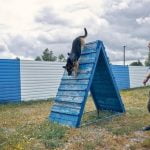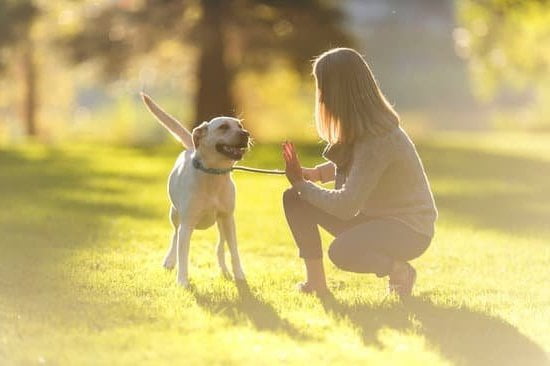Training a dog to stay with you is an essential skill that every responsible dog owner should prioritize. Whether you’re taking them for a walk in the park or bringing them on an outing, having a well-trained dog that stays by your side can significantly enhance both control and safety. In this article, we will delve into the importance of teaching a dog to stay with you and provide practical tips and techniques for successful training.
Establishing Trust and Bonding with Your Dog is crucial before embarking on any training journey. Building a strong bond with your furry friend lays the foundation for effective communication and cooperation during training sessions. We’ll explore various methods to establish trust, including positive reinforcement, consistent training routines, and understanding your dog’s individual needs.
Setting Up a Proper Training Environment is critical for successful teaching. Dogs rely heavily on their senses, so it’s essential to create a distraction-free space where your pup can focus and learn. We will discuss the importance of selecting an appropriate training area that minimizes external stimuli and offers an environment conducive to concentration. With the right setup, training sessions become more productive, enabling quicker progress in teaching your dog to stay with you.
Establishing Trust and Bonding with Your Dog
Building a strong bond and establishing trust with your dog is a crucial first step in training them to stay with you. Dogs are social animals, and by forming a strong emotional connection, you can create an environment conducive to learning and obedience. Here are some essential methods to help you foster that bond:
Positive Reinforcement
Using positive reinforcement techniques is an effective way to build trust with your dog. By rewarding desired behaviors with treats, praise, or playtime, you create a positive association between obeying commands and receiving rewards. Consistently providing positive reinforcement will help your dog understand that staying close to you is beneficial.
Consistent Training
Consistency is key when building trust with your furry friend. Establish regular training sessions where you dedicate time solely to working on obedience and reinforcing the bond between you. It’s important to remember that dogs thrive on routine, so try to stick to a consistent schedule of training exercises.
Understanding Needs
Taking the time to understand your dog’s needs is another essential aspect of building trust. Dogs require physical exercise, mental stimulation, and social interaction. Meeting these needs will contribute to their overall well-being and make them more receptive during training sessions.
By creating a strong foundation built on trust and bonding, you are setting yourself up for success when it comes to training your dog to stay with you. However, keep in mind that establishing this bond requires patience, consistency, and understanding. With time and effort invested into building this relationship, both you and your furry companion will benefit from a stronger connection throughout the training process.
As mentioned earlier, it’s important not to rush through this crucial step before diving into teaching the “stay” command or other obedience exercises. Take the necessary time needed for trust-building activities before moving forward in the training process.
Setting Up a Proper Training Environment
Creating an appropriate training environment is crucial when teaching a dog to stay with you. The right environment can help minimize distractions and maximize focus during training sessions. Here are some tips for setting up a proper training environment:
- Find a Quiet and Distraction-Free Space: Choose an area in your home or backyard where you can have your dog’s undivided attention. This space should be free from loud noises, other pets, and household activities that could distract your dog.
- Remove Tempting Objects: Make sure there are no objects within your dog’s reach that may pique their curiosity or provide an unwanted stimulus. Removing toys, food bowls, or any other items that may distract them will help maintain their focus on the training session.
- Use Visual Barriers if Necessary: If your dog tends to get easily distracted by what’s happening around them, consider using visual barriers to limit their view of the outside world. Closing curtains or using baby gates can help create a more controlled training environment.
- Implement Consistent Training Times: Schedule regular training sessions at the same time each day to establish a routine and familiarity for your dog. Consistency in timing will help them understand when it’s time to focus and learn.
- Use Proper Lighting: Adequate lighting is essential for both you and your dog during training sessions. Make sure the area is well-lit so that you can clearly see each other’s body language and cues.
Remember, creating a distraction-free training environment doesn’t mean isolating your dog from all stimuli permanently; it simply provides an optimal condition for effective learning. As your dog progresses in their training, gradually introduce controlled distractions to practice the “stay” command in real-life situations.
Setting up a proper training environment will enhance the success of teaching your dog to stay with you. It allows them to concentrate on learning without being overwhelmed or easily distracted by external factors. By creating this dedicated space for training sessions, you can facilitate the learning process and lay a solid foundation for your dog’s ability to stay with you in various situations.
Teach the “Stay” Command Step-by-Step
Teaching your dog the “stay” command is an essential part of their training. It allows you to have better control and ensures their safety during walks or outings. Before diving into the step-by-step process of teaching the “stay” command, it is crucial to have a strong foundation by teaching your dog basic commands like “sit” and “down.” These commands serve as prerequisites for the “stay” command and help establish discipline and focus.
- Start with Basic Commands: Begin by teaching your dog basic commands such as “sit” and “down.” Use positive reinforcement techniques like treats and praise to reward them when they successfully follow these commands. Consistency is key here, so make sure to practice these basic commands regularly until your dog responds reliably.
- Introduce the Concept of Stay: Once your dog has mastered the basic commands, introduce the concept of staying in one place. Begin by giving the command to sit or lie down, then take a small step back while maintaining eye contact with your dog. If they remain in position, quickly return to them, reward them with a treat, praise, or playtime, and release them from the command.
- Gradually Increase Distance and Duration: As your dog becomes more comfortable with staying in one place, gradually increase both the distance from them and the duration of their stay. Start by taking two steps back instead of just one, then three steps, and so on.
Similarly, extend the duration by waiting a little longer before returning to reward them. However, remember not to progress too quickly; always work at a pace that ensures success for your dog.
It’s important to note that each session should be short (10-15 minutes) but frequent (multiple times a day). Repetition is key when it comes to reinforcing this command, so make sure to practice in different environments and gradually introduce distractions once your dog consistently follows the stay command in a quiet, distraction-free space.
By following these step-by-step instructions, you can effectively teach your dog the “stay” command. Remember to be patient, encourage positive reinforcement, and maintain consistency throughout the training process. With practice and dedication, your dog will acquire this valuable skill that will enhance their safety and strengthen your bond.
Utilizing Positive Reinforcement Techniques
Training a dog to stay with you is an essential skill that not only promotes better control and safety but also strengthens the bond between you and your furry companion. One effective technique to achieve success in training is by utilizing positive reinforcement. Positive reinforcement involves rewarding your dog for exhibiting the desired behavior, which helps them associate staying with you as a positive experience.
One of the most common forms of positive reinforcement is treats. When your dog successfully stays with you, immediately reward them with their favorite treat. This helps create a positive association with staying and motivates them to continue behaving in that manner. It’s important to choose high-value treats that your dog finds extra enticing, as this will increase their willingness to comply.
In addition to treats, praise and verbal affirmations play a significant role in reinforcing the desired behavior. Whenever your dog stays with you, shower them with enthusiastic praise and use phrases like “good boy” or “good girl.” Dogs thrive on hearing positive feedback from their owners, and it reinforces their understanding that they are doing the right thing.
It’s crucial to ensure consistency when utilizing positive reinforcement techniques during training sessions. This means consistently rewarding your dog every time they successfully stay with you. Over time, your furry friend will come to understand that staying close to you is beneficial and enjoyable, thus making it easier for them to learn and maintain the behavior. Remember, building trust and strengthening the bond between you and your pet is key throughout this process.
Addressing Common Challenges and Troubleshooting
Identifying Distractions and Maintaining Focus
During the training process, it is common for dogs to become easily distracted or have difficulty maintaining focus on the “stay” command. It is important to identify potential distractions in your training environment and find ways to minimize their impact. For example, if you are training at home, turn off the TV or put away toys that might tempt your dog. Gradually introduce distractions once your dog has mastered the command in a controlled environment.
To help your dog maintain focus during training sessions, consider using visual cues such as hand signals or target sticks. These cues can provide additional guidance and clarity for your dog while minimizing verbal distractions. Additionally, make sure to choose a time when your dog is calm and not overly excited or energetic, as this can make it more difficult for them to concentrate.
Building Engagement and Motivation
Another common challenge when training a dog to stay with you is building engagement and motivation. Some dogs may lack interest in the training process or may only respond to certain types of rewards. It is essential to find what motivates your specific dog and use it as a reward during training.
Experiment with different treats, toys, or playtime activities that your dog finds particularly enjoyable. Use these rewards generously during training sessions to create a positive association with the “stay” command. Remember that consistency is key; always reward your dog immediately after they successfully comply with the command.
If you notice decreased motivation from your dog during training sessions, take breaks and keep sessions short to avoid overwhelming them. Keeping training sessions fun and engaging will help maintain their interest throughout the process.
Overcoming Reliance on Physical Cues
Some dogs may become overly reliant on physical cues, such as hand signals or body language, rather than truly understanding the “stay” command itself. To overcome this challenge, gradually reduce the use of physical cues and focus on verbal commands.
Start by using a combination of both verbal and physical cues, gradually fading out the physical cues while reinforcing the verbal command. For example, if you initially taught your dog to stay by raising your hand as a signal, start lowering it gradually until your dog can respond solely to the spoken command.
Consistency is crucial during this process. Make sure everyone in your household uses consistent verbal commands and avoids giving mixed signals. With patience and practice, your dog will develop a strong understanding of the “stay” command independent of physical cues.
By addressing these common challenges and utilizing appropriate troubleshooting strategies, you can overcome obstacles during the training process and ensure that your dog masters the “stay” command effectively. Remember to be patient, consistent, and always reward desired behavior to build a solid foundation for a lifelong skill.
Incorporating Real-Life Situations and Distractions
Once your dog has grasped the basics of the “stay” command in a controlled environment, it is crucial to transition to real-life situations and introduce distractions. This will help ensure that your dog can stay focused and obedient even when faced with external stimuli.
Gradual Introduction of Distractions: When incorporating real-life situations, it is essential to start with low-level distractions and gradually increase the difficulty level as your dog becomes more proficient. For example, you can begin by introducing mild distractions such as toys or treats placed nearby while practicing the “stay” command. As your dog becomes more comfortable, progress to more challenging distractions such as passing cars or other animals.
Maintain Consistency: Consistency is key when incorporating real-life situations and distractions into training sessions. Remember to use the same verbal cue for the “stay” command that you have been using during controlled training sessions. Reinforce the behavior with treats and praise whenever your dog successfully stays in place despite the distraction.
It is important to note that you should never punish or scold your dog for breaking the stay during this phase of training. Instead, calmly redirect their attention back to you and restart the exercise if necessary. Consistency will help reinforce positive behaviors and build a stronger foundation for reliability in challenging environments.
To further enhance training, consider enrolling in group obedience classes or arranging playdates with well-behaved dogs as an opportunity for controlled socialization.
| Tips for Incorporating Real-Life Situations and Distractions |
|---|
| – Start with low-level distractions and gradually increase difficulty. |
| – Use consistent verbal cues. |
| – Reinforce positive behavior with treats and praise. |
| – Calmly redirect attention if the dog breaks the stay. |
| – Consider group obedience classes or controlled socialization opportunities. |
Continuing Training and Reinforcement
Once your dog has mastered the “stay” command, it is crucial to continue training and reinforcement to ensure that they understand and obey the command in various situations. Ongoing practice will help solidify the behavior and make it a lifelong skill for your dog. Here are some tips on how to continue training and reinforcement:
- Consistency: Maintain consistent expectations and reinforce the “stay” command regularly. Use it in everyday situations like mealtime or when answering the doorbell. This consistency will help your dog understand that staying still is expected behavior regardless of distractions.
- Gradual Increase of Difficulty: As your dog progresses, gradually increase the level of difficulty by introducing new distractions or variables. Start with simple distractions like toys or treats on the ground, then work up to more challenging distractions like squirrels or other dogs.
- Incorporate Real-Life Situations: Practice the “stay” command in different environments and situations to generalize the behavior. Take your dog to parks, busy streets, or crowded areas while practicing their “stay” command. This will help them stay calm and focused even in distracting settings.
- 4.Fun Games and Activities: Keep training sessions enjoyable for both you and your dog by incorporating games that involve the “stay” command. For example, you can play hide-and-seek where you ask your dog to stay while you hide, then reward them when they find you.
| Tips | Methods |
|---|---|
| Maintain consistency | Use in everyday situations |
| Gradually increase difficulty | Introduce new distractions or variables |
| Incorporate real-life situations | Practice in different environments |
| Fun games and activities | Make training enjoyable |
By continuing to train and reinforce the “stay” command, you are ensuring that your dog retains the skills they have learned and is able to apply them in a variety of situations. This ongoing practice will solidify their understanding of the command and strengthen your bond with your furry companion.
Remember to make training sessions fun and engaging for your dog, using positive reinforcement techniques such as treats and praise. With consistent effort, you’ll have a dog who not only stays with you but also remains obedient and well-behaved throughout their life.
Conclusion
In conclusion, training your dog to stay with you is a lifelong skill that brings numerous benefits for both you and your furry companion. By establishing trust and bonding with your dog, creating a proper training environment, and utilizing positive reinforcement techniques, you can effectively teach your dog the “stay” command. Additionally, addressing common challenges, incorporating real-life situations and distractions, and continuing training and reinforcement are essential factors in achieving a reliable “stay” command.
The importance of teaching your dog to stay with you cannot be overstated. It serves as a foundation for better control and safety during walks or outings. When your dog has mastered the “stay” command, it allows you to have peace of mind knowing that they will remain by your side in potentially dangerous situations. This skill also enhances communication between you and your dog, strengthening your bond and building mutual trust.
To achieve success in training your dog to stay with you, it is crucial to establish a strong bond based on trust. Positive reinforcement techniques such as treats, praise, and rewards are effective in motivating and reinforcing desired behavior. By creating a distraction-free training environment and gradually introducing real-life situations and distractions, you can ensure that your dog understands the “stay” command regardless of the circumstances.
Remember that training is an ongoing process. Consistency is key in reinforcing the “stay” command throughout different stages of your dog’s life. By incorporating fun games or activities that incorporate the “stay” command into your daily routine, you can continue strengthening this skill while ensuring that learning remains enjoyable for both you and your furry companion.
Frequently Asked Questions
How can I train my dog to stay by me?
To train your dog to stay by you, it is important to start with the basics of obedience training. Begin by teaching your dog the “sit” and “stay” commands separately before integrating them together. Start in a distraction-free environment and gradually increase the level of distractions as your dog becomes more proficient.
Use positive reinforcement techniques such as treats or praise when your dog successfully stays by your side. It is essential to be patient and consistent during training sessions, keeping them short and engaging for your dog. With time, practice, and consistency, your dog will learn to stay by you.
How do I train my dog to come when called every time?
Training a dog to come when called every time requires consistency, patience, and positive reinforcement. Start training in a quiet and controlled environment using a long leash to prevent your dog from running off initially. Call their name followed by the command “come,” using an upbeat tone of voice.
Reward them generously with treats or praise when they come to you promptly. Gradually introduce distractions into the training sessions, increasing the difficulty over time as your dog becomes more reliable in their recall response. Avoid punishing or scolding them if they don’t come immediately; instead, focus on reinforcing the behavior you desire.
How long does it take to train a dog to stay?
The duration required to train a dog to stay can vary based on several factors such as the breed, age, temperament, and previous training experience of the dog. Some dogs may learn the concept of staying relatively quickly within a few weeks of consistent training sessions, while others may take several months to become reliably trained in this behavior.
It is important to remember that each dog learns at its own pace, so patience is necessary during the training process. Consistency in training methods and regular practice are key elements for achieving desired results in teaching a dog to stay obediently for prolonged periods.

Welcome to the blog! I am a professional dog trainer and have been working with dogs for many years. In this blog, I will be discussing various topics related to dog training, including tips, tricks, and advice. I hope you find this information helpful and informative. Thanks for reading!





